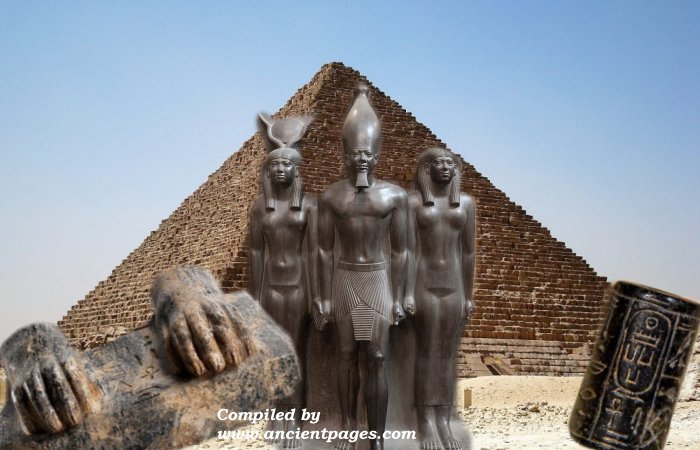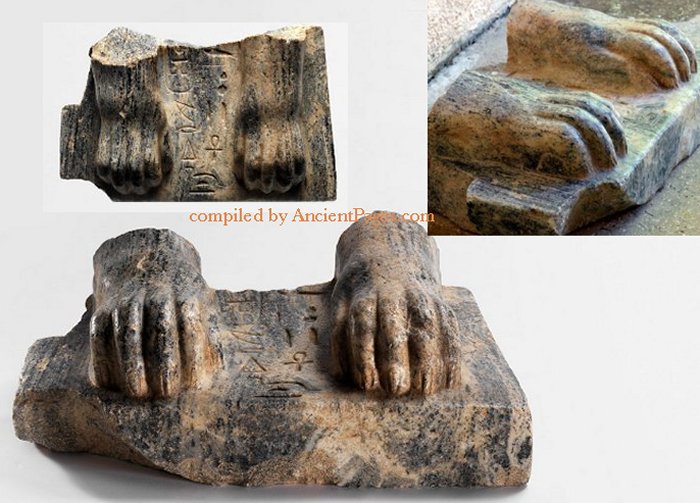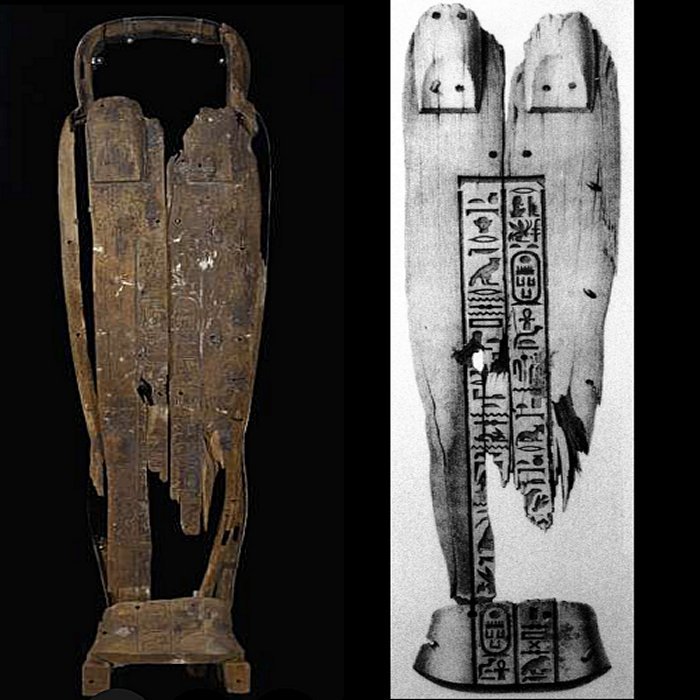A. Sutherland – AncientPages.com – Giza pyramids belong to Khufu, Khafre, and Menkaure, and vandals and thieves looted them long ago. The southernmost is ᴀssociated with Menkaure (Mykerinos, in Greek), the fifth king of the 4th Dynasty.
Who Was Pharaoh Menkaure?
Menkaure was the eldest son of Pharaoh Khafre, the grandson of Khufu (Cheops), and ruled in the middle of the third millennium BC, from about 2490 to -2473, though the length of Menkaure’s reign is uncertain. His wives were Queens Khamerernebty II and Rekhetre, while Shepseskaf was the successor to Menkaure and probably his son.

He also had a daughter who had a very uncomfortable relationship with her father. Herodotus mentions that he possessed his daughter against her will, and when she couldn’t bear the shame of it anymore, she hanged herself. The Pharaoh never overcame his grief and guilt.
Menkaure became famous for his pyramid tomb at Giza and his beautiful statue triads, showing the king, goddesses, and his wife, Khamerernebty. Unlike his grandfather, Khufu, Menkaure had many statues and high reliefs that allowed us to see him. The most famous of these representations is the triad, a high relief depicting Menkaure, with the goddess Hathor by his side and a nome’s personification of a province.
The name of Menkaure was found written on scarabs dated to the 26th Dynasty, which may imply that he was worshiped in this period.
Sphinx With Inscribed Name Of The King Menkaure
Scarce material evidence about the reign of Menkaure is represented by fragments of vessels inscribed with his name.
 Fragment of a sphinx of King Menkaure (Mycerinus). Image credit: Israel Antiquities Authority
Fragment of a sphinx of King Menkaure (Mycerinus). Image credit: Israel Antiquities Authority
Fragment of a sphinx of King Menkaure (Mycerinus) was unearthed in Late Bronze Age Hazor in a context postdating Menkaure’s reign by more than a thousand years.
The king’s name was engraved between the sphinx’s legs, discovered in Tel Hatzor (Canaan), Israel, in 2013.
Menkaure A Good And Righteous Ruler
During the reign of Khufu and Khafre, Egypt suffered severe disasters. Temples were closed, and the Egyptians – free citizens and enslaved people – worked day and night, building pyramids for their rulers.
Menkaure changed the people’s situation significantly by opening the temples, reducing restrictions on the people exhausted by poverty, letting them work in their fields, and offering sacrifices. He was considered the most righteous ruler of all. The Egyptians loved him and did not know how to thank the gods for sending them such a just, kind, and intelligent Pharaoh.
Menkaure Struck By Heavy Blows Of Fate
The first disaster that befell him was the death of his beloved daughter, who committed suicide, and then, the Oracle of Buto predicted that Menkaure would live for only six more years.
 Sepulchral Chamber of Men-ka-ra. Men standing in a high-ceilinged tomb chamber. Image source
Sepulchral Chamber of Men-ka-ra. Men standing in a high-ceilinged tomb chamber. Image source
After hearing this prophecy, Pharaoh sent messengers to the oracle Maat. The messengers asked the goddess of world order:
“The father and grandfather of the great Menkaure locked the temples, did not honor the gods, oppressed the people, and lived happily until a ripe old age. Why should a pious and kind Pharaoh die in six years?
Is this fair? And Maat answered the messengers:
“Menkaure is kind and fair – that’s why I shortened his life. He did not do what he had to: Egypt was destined to endure calamities for 150 years. Khufu and Khafra understood this, but Menkaure did not understand.
If he had stopped doing good and would have become a cruel and unjust ruler, Maat might have canceled her sentence. After all, she spared Pharaoh Khufu, who tried to act contrary to fate.
Menkaure Tried To Outsmart Fate
It is difficult to outsmart fate, but the ruler tried to do it.
He ordered that as night fell, candles were to be lit, and he continued to live by day and night, drinking and pursuing amusements. He decided to turn ‘his nights into days, and thus, he could extend his remaining years from six to twelve.’ (Herodotus, Histories, 2.129-133).
Theoretically, he expanded his reign from six to twelve years. However, the gods were not to be denied, and as the legend has it, Menkaure died after the six postulated calendar years.
Interior Of Menkaure’s Pyramid
The Pharaoh died before his pyramid was finished. Menkaure could rule for 12 years (or 18 years). He had enough time to build his pyramid as giant as the other two pyramids of Giza, but he did not. Also, a great series of slate triads was never finished. The majority were found in various stages of completion. Menkaure may not have enough time to supervise construction works.
 Left: Fragments of the lid of a wooden coffin have been found, probably from a restoration of the burial from the 26th Dynasty. The inscriptions on the wooden coffin name the owner “Osiris Menkaure, to whom eternal life was given, born from heaven, from the sky goddess Nut over you…” The coffin and skeletal remains are now in the British Museum. Right: Drawing of the anthropoid coffin fragment inscribed with the name of the king Menkaura made by excavator Richard Vyse and published in 1840. source
Left: Fragments of the lid of a wooden coffin have been found, probably from a restoration of the burial from the 26th Dynasty. The inscriptions on the wooden coffin name the owner “Osiris Menkaure, to whom eternal life was given, born from heaven, from the sky goddess Nut over you…” The coffin and skeletal remains are now in the British Museum. Right: Drawing of the anthropoid coffin fragment inscribed with the name of the king Menkaura made by excavator Richard Vyse and published in 1840. source
The story preserved in the legends says that he met his death suddenly.
Menkaure’s unfinished pyramid was not higher than those of his father and grandfather, but the coating was beautifully polished, which can still be seen today.
The coating stones are smooth to a certain extent and then curved. The pyramid of Menkaure has a remarkable interior. Most of this structure’s interior spaces are located below ground level; the burial chamber is 15.5 meters below the pyramid’s base and carved into the rock.
It must have been an incredible performance. There was also a cedar coffin. On it was depicted relief decoration, namely the side of the royal palace and the complex of the Pyramid of Djoser in Saqqara.
False Burial Chamber
There is one more, apparently false, pyramid burial chamber. The entrance here begins about four meters above the ground, from where the corridor descends to the base’s level. From there, it continues through a horizontal pᴀssage to the chamber, which is four meters high. The false section was supposed to fool any potential thieves. Only from this room leads a tilted tunnel to the real burial chamber.
The Sea Swallowed Sarcophagus Along With ‘Beatrice’ Ship
In 1837, archaeologist Howard Vyse and his team discovered the burial chamber containing an empty sarcophagus made of basalt, a mummy-shaped coffin lid made of wood, and some bones. These bones were later dated from the early Christian era and had no connection to Pharaonic times.
On the other hand, the basalt sarcophagus could have belonged to Menkaure, but unfortunately, nobody had the opportunity to examine it. After its discovery, it was loaded onto the ship Beatrice and sent to the British Museum in London for display. Unfortunately, it never arrived there.
In 1838, the ship sank off Spain’s coast, and the coffin ended on the bottom of the Mediterranean Sea. The wooden mummy-shaped coffin reached the British Museum, but all efforts to locate the shipwreck and the lost basalt sarcophagus of Menkaure failed.
The sea has swallowed many ships, and ‘Beatrice’ was one of them. Fortunately, the coffin reached the Museum because it traveled on another boat.![]()
Article in Portuguese – here
Written by – A. Sutherland – AncientPages.com Senior Staff Writer
Updated on Sep 30, 2023
Copyright © AncientPages.com All rights reserved. This material may not be published, broadcast, rewritten or redistributed in whole or part without the express written permission of AncientPages.com
Expand for references
References:
Rigano Ch. Pyramids of the Giza Plateau
source 1
Source 2





